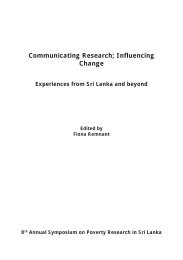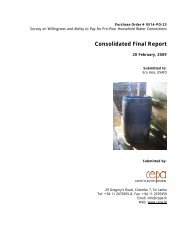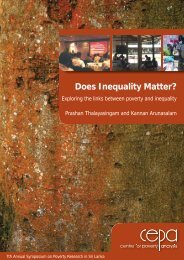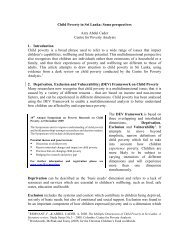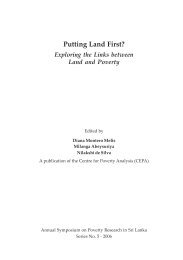Involuntary Displacement and Resettlement â Policy and ... - CEPA
Involuntary Displacement and Resettlement â Policy and ... - CEPA
Involuntary Displacement and Resettlement â Policy and ... - CEPA
- No tags were found...
You also want an ePaper? Increase the reach of your titles
YUMPU automatically turns print PDFs into web optimized ePapers that Google loves.
decision making process has increased the cost. The fact that the loanfinancing of the STDP did not cover any part of the compensation paymentshas put severe strain on the state budget. Subsequent road developmentwhich attempted to include LARC entitlements in the compensation structurewere stalled due to the large budgetary requirements. This has given rise toa school of thought that the continuation of LARC will seriously inhibit largescale infrastructure development.Clearly, there is a need to balance the public need for infrastructure with theprivate loss of individual households who are subjected to l<strong>and</strong> acquisition<strong>and</strong> involuntary resettlement. A ‘fair’ compensation would be one whichallows affected persons to replace their lost l<strong>and</strong> <strong>and</strong> assets at a level that isin line with their previous st<strong>and</strong>ard of living <strong>and</strong> livelihoods. The cost ofcompensation needs to be included in the cost-benefit calculations of adevelopment project. This is particularly critical where those losing theirassets <strong>and</strong> those directly benefiting from the development do not overlap.Where the monetary cost of compensation payments is prohibitive,non-monetary assistance would need to be planned <strong>and</strong> implemented.The composition of LARC, which mixes authority with technical <strong>and</strong> localknowledge <strong>and</strong> its location in the DS office with its universal access were keyfeatures that contributed to the final outcome. The committees, in mostinstances, have succeeded in providing an acceptable level of consultationwhich is reflected in the APs attitude that LARC provided the best solutionsto a bad situation. There is however, a need to look more closely atachieving a balance between flexibility that allows the committees to addressthe specific issues faced by different households <strong>and</strong> regions, <strong>and</strong> thest<strong>and</strong>ardisation needed to ensure equity between persons <strong>and</strong> acrossadministrative regions. The experience of the LARC process in the STDP casepoints to the structure of allowances being more transparent, <strong>and</strong> therebyless controversial, than the ‘top-up’ of the statutory payment for l<strong>and</strong> <strong>and</strong>structures. However, providing similar solutions to similar problems is criticalfor equity, as well as to retain the goodwill created by providing a space forconsultation.A second aspect is the concern that LARC creates a privileged group ofpersons among those affected by state l<strong>and</strong> acquisitions. Within the sameregions l<strong>and</strong> acquired for other state needs only entitled the owners to thestatutory compensation. The significantly higher compensation, paid by the174



